The Airway Disease Treatment Market is estimated to be valued at USD 2.3 billion in 2025 and is projected to reach USD 3.9 billion by 2035, registering a compound annual growth rate (CAGR) of 5.2% over the forecast period.
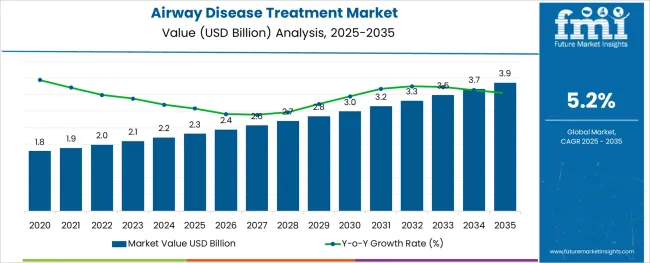
The airway disease treatment market is witnessing significant momentum, driven by rising global respiratory disease prevalence, urban air pollution, and expanding access to advanced therapeutics. Strategic investment in pulmonary healthcare infrastructure, coupled with supportive public health campaigns, has enhanced early diagnosis and treatment access across both developed and emerging markets.
Pharmaceutical innovation, particularly in biologics and inhalation delivery systems, is supporting better clinical outcomes and long-term disease control. Regulatory approvals for targeted therapies and patient-focused digital inhaler solutions are expected to further reshape treatment protocols.
Additionally, rising demand for home-based care, personalized medicine, and integration of real-time monitoring devices is paving the path for future innovation in airway disease management.
The market is segmented by Type, Treatment, and End-user and region. By Type, the market is divided into Asthma, Chronic Obstructive Pulmonary Disorder, and Bronchiectasis. In terms of Treatment, the market is classified into Bronchodilators, Corticosteroids, Cytotoxic Drugs, Oxygen Therapy, Antibiotics, and Others.
Based on End-user, the market is segmented into Hospitals, Clinics, ASCs, Rehabilitation Centers, and Others. Regionally, the market is classified into North America, Latin America, Western Europe, Eastern Europe, Balkan & Baltic Countries, Russia & Belarus, Central Asia, East Asia, South Asia & Pacific, and the Middle East & Africa.
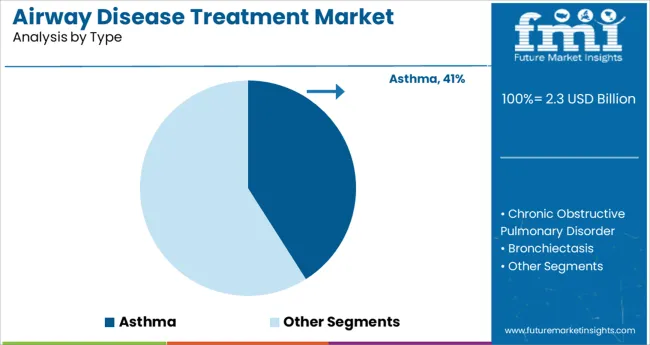
Asthma is anticipated to represent 41.0% of the total revenue in the airway disease treatment market by 2025, making it the dominant disease type. This leadership is being driven by its high global prevalence, chronic nature, and increasing incidence among both children and adults.
The rise in allergens, pollution levels, and sedentary lifestyles has contributed to rising caseloads globally. Advancements in disease management protocols-such as maintenance and reliever therapy (MART)-have improved long-term treatment adherence.
Continued awareness campaigns and public health programs targeting asthma control have also contributed to more structured diagnosis and early intervention, supporting the segment’s sustained growth trajectory.
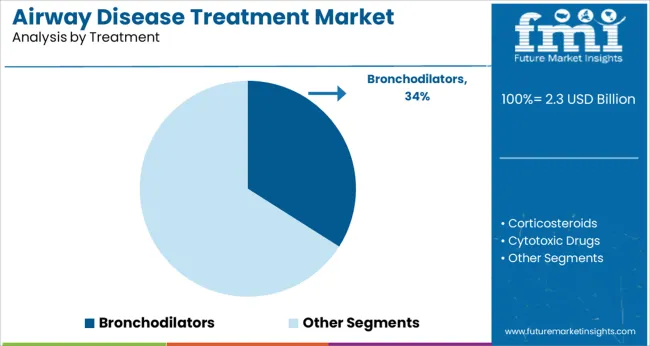
Bronchodilators are projected to hold 34.0% of the total market share in 2025, making them the most widely prescribed treatment category. Their dominance is supported by their rapid onset of action, affordability, and wide applicability in both acute and maintenance therapy across multiple respiratory disorders.
The segment has benefited from ongoing enhancements in drug formulations and delivery mechanisms, particularly metered-dose and dry-powder inhalers. Their role as first-line treatment in emergency and chronic care settings has reinforced their position across healthcare systems.
Increased over-the-counter availability in certain regions and their incorporation into global treatment guidelines have further strengthened their widespread adoption.
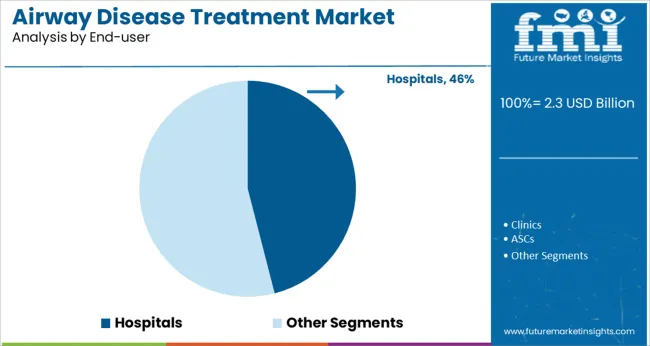
Hospitals are expected to account for 46.0% of the market revenue in 2025, positioning them as the leading end-user in airway disease treatment. This is largely due to the availability of advanced respiratory care infrastructure, critical care facilities, and access to multidisciplinary medical teams.
Hospitals also remain central for managing acute exacerbations and severe airway disease cases, particularly those requiring continuous oxygen therapy or nebulization. Strong insurance support, government-funded respiratory programs, and reimbursement-driven healthcare utilization have further reinforced hospitals as primary treatment centers.
Additionally, the rising incidence of hospitalization due to respiratory complications has driven investment in pulmonary departments, enhancing patient throughput and specialized care.
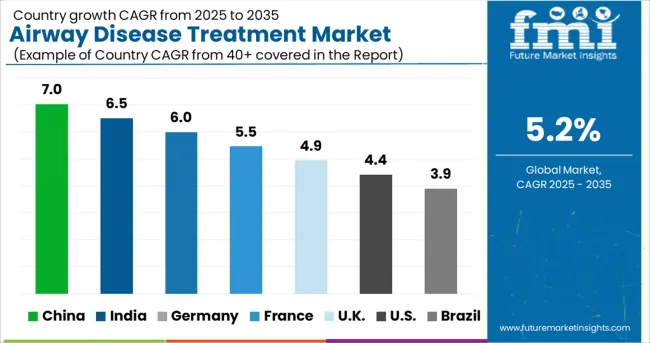
During the projection period, the Asia Pacific market is expected to grow at a faster rate. The growing presence of major products in the region is expected to fuel demand for asthma medications between 2025 and 2035.
Due to the existence of major players, China and Japan are projected to provide considerable potential in the market. For example, the rise of Pulmicort, a crucial asthma medicine, in the area has been driven by a favorable performance in China.
This factor, together with the availability of a huge and underserved market in the region, is expected to fuel market expansion in the Asia Pacific throughout the projection period. The rest of the international market, which includes Latin America, the Middle East, and Africa, is still in its infancy.
However, it is anticipated that throughout the projection period, rising chronic respiratory illness incidence and rising product introductions, especially effective generic asthma treatments, are likely to drive demand for airway disease treatments.
Globally, growing nations are opening up significant potential in the market for the treatment of respiratory disorders due to the high incidence of respiratory illnesses, increased accessibility to high-quality healthcare services, and expansion of the pharmaceutical sector.
The market for airway disease treatment has numerous growth opportunities due to the quick uptake of new technology and a surge in innovation.
During the drug development phase, pharmaceutical companies devote a significant amount of both monetary and non-monetary resources. The companies are completely in charge of the drug's manufacture and manufacturing while they have the patents for it.
The original pharmaceutical producer suffers significant losses as a result of generic drug manufacturers using the formula to produce their versions of the medications, which poses a difficult situation for the expansion of the global market.
As these businesses are positioned to acquire market share throughout the forecast period through the increased sales of their product offerings, this is anticipated to have a favorable influence on the airway disease treatment market growth.
The market's competitive landscape shows a monopoly market structure with a large number of enterprises present. Due to the strength of their products in terms of asthma medications, two companies, AstraZeneca and GlaxoSmithKline dominated this industry.
The most notable products for GlaxoSmithKline were Advair and Flovent HFA/Flovent Diskus. These are the key elements that have contributed significantly to these firms' leading market positions. However, there are other well-known market participants, like Merck and Teva, which have sizable market revenue shares in the international market.
A generic asthma medication called fluticasone propionate and salmeterol inhalation powder, which is intended for the treatment of both asthma and chronic obstructive pulmonary disease, has completed phase III clinical research, according to Cipla Inc. (COPD). This potential possibility is the 100/50 mcg generic version of Advair Diskus.
Among the medications used in combination therapy for COPD are LABA-ICS, LAMA-ICS, triple therapy, and other similar drugs. Due to its superior efficacy over using a bronchodilator and a corticosteroid separately, combination therapy is becoming more popular, propelling the demand for airway disease treatment.
The airway disease treatment market growth is likely to augment owing to a rise in the number of patients who are successfully treated with combination therapy but who were not responding to bronchodilators or corticosteroid treatments. In addition, the adoption of airway disease treatment soars as the symptoms and quality of life of patients with chronic obstructive pulmonary disease can be improved more successfully with combination therapy than with monotherapy.
Combination therapy has also gained traction on account of recent regulatory approvals and a rise in the success rate of the treatment for COPD, aiding the overall market. Furthermore, the development of cutting-edge therapeutics for asthma by major market players is one of the critical factors holding sway over the airway disease treatment market trends and forecasts.
The adoption of airway disease treatment is facilitated by market characteristics such as solid and robust Research and Development efforts. One of the significant airway disease treatment market trends is the involvement of well-known pharmaceutical companies in the development of asthma medications, as asthma is a chronic disease that affects a sizable number of patients worldwide.
As part of this involvement, several promising asthma treatment candidates are currently undergoing various stages of clinical trials, influencing airway disease treatment adoption trends. For instance, in September 2020, Novartis released encouraging data from the phase III IRIDIUM study of the inhaled combination QVM149 in patients with uncontrolled asthma.
On account of the rising prevalence of respiratory diseases such as asthma, cystic fibrosis, and COPD across the world, the demand for airway disease treatment is expected to skyrocket to a considerable extent. And the same can be primarily owed to the highly susceptible elderly people to respiratory diseases (COPD, asthma, emphysema) due to reduced immunity and blood flow.
Furthermore, the airway disease treatment market's key trends & opportunities are shaped by the introduction of advanced imaging technologies such as digital radiography and computed radiography as they render high-quality digital images.
Digital imaging systems have witnessed a low adoption rate as these are more expensive than analog imaging systems, dwindling the overall airway disease treatment market size during the forecast period. Since the pandemic and asthma are closely related to respiratory illnesses, there is an increased need for various types of asthma treatment medications, in turn, spiking the demand for airway disease treatment.
Due to rising demand and adoption of airway disease treatment, the USA FDA has granted priority regulatory approvals to several asthma medications, including important generic alternatives.
A key generic asthma treatment drug from Cipla, for example, received regulatory approval from the USA FDA in April 2024. Lupin is also expected to receive regulatory approval for a generic version of the same medication, auguring well for the airway disease treatment market's future trends.
The market is also positively impacted by the surging release of products with significant capability from well-known companies as a result of such developments and trends. Further efforts are made to prevent significant shortages of asthma medications by launching an increasing number of products.
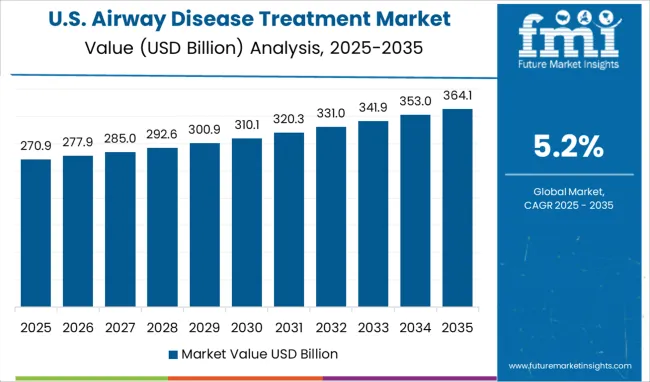
Geographically, North America is anticipated to hold a major chunk of the airway disease treatment market share accounting for 38.1% in 2025.
The dominance of North America can be attributed to the rising incidence of respiratory diseases, the popularity of portable electronics, and the rising need for equipment and services for in-home medical care.
According to the American Lung Association, COPD is the third most common cause of death in the country. Additionally, a growing need for cutting-edge and inventive products in medical facilities, diagnostic labs, and outpatient ambulatory surgery centers would drive market expansion in the region.
Europe holds second place in the market for treatments for airway disease, projected to dominate a market share of 22.5% in 2025.
The region's market is being driven by a well-established healthcare system and an increase in the prevalence of chronic obstructive pulmonary disease and Asthma is the most common issue among children.
A number of technological advancements in respiratory diagnostic testing have paved the way for the market's expansion, including the use of artificial intelligence and the Internet of things (IoT), among other things.
A USA-based start-up, Altavant Sciences, is advancing therapies for managing rare respiratory diseases. The company's lead drug candidate, rodaristat ethyl, is a small molecule inhibitor of tryptophan hydroxylase (TPH).
The medication reduces serotonin levels in conditions like PAH and idiopathic pulmonary fibrosis (IPF). The start-up is also working on medicines to treat bronchiolitis obliterans syndrome. Exvastat, a British start-up, creates a drug that is modified to treat acute respiratory distress syndrome (ARDS).
Imatinib, a medication used to treat chronic myeloid leukemia, is being reformulated by the start-up. The newly developed medication makes use of its capacity to obstruct vascular leak, a cause of pulmonary edema.
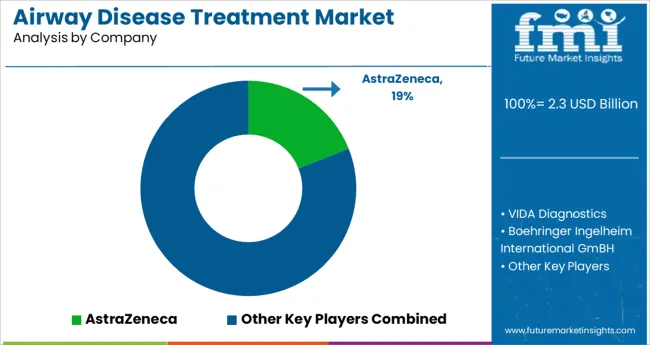
Currently, the global airway disease treatment market is highly competitive owing to the involvement of many established players.
Some of the key players in the global airway disease treatment market are Holaira, Inc., VIDA Diagnostics, Boehringer Ingelheim International GmBH, AstraZeneca, Teva Pharmaceuticals, GlaxoSmithKline and Novartis.
Some of the recent developments in the airway disease treatment market are:
For people with asthma, this drug is frequently regarded as a last resort.
| Report Attribute | Details |
|---|---|
| Growth Rate | CAGR of 5.2% from 2025 to 2035 |
| Base Year for Estimation | 2024 |
| Historical Data | 2020 to 2024 |
| Forecast Period | 2025 to 2035 |
| Quantitative Units | Revenue in USD Million and CAGR from 2025 to 2035 |
| Report Coverage | Revenue Forecast, Volume Forecast, Company Ranking, Competitive Landscape, Growth Factors, Trends, and Pricing Analysis |
| Segments Covered |
Type, Treatment, End Use, Region |
| Regions Covered |
North America; Latin America; Western Europe; Eastern Europe; Asia Pacific; Japan; The Middle East and Africa |
| Key Countries Profiled |
United States of America, Canada, Brazil, Argentina, Germany, United Kingdom, France, Spain, Italy, Nordics, BENELUX, Australia & New Zealand, China, India, ASEAN, GCC Countries, South Africa |
| Key Companies Profiled |
Holaira, Inc.; VIDA Diagnostics; Boehringer Ingelheim International GmBH; AstraZeneca; Teva Pharmaceuticals; GlaxoSmithKline; Novartis |
| Customization | Available Upon Request |
The global airway disease treatment market is estimated to be valued at USD 2.3 USD billion in 2025.
It is projected to reach USD 3.9 USD billion by 2035.
The market is expected to grow at a 5.2% CAGR between 2025 and 2035.
The key product types are asthma, chronic obstructive pulmonary disorder and bronchiectasis.
bronchodilators segment is expected to dominate with a 34.0% industry share in 2025.






Full Research Suite comprises of:
Market outlook & trends analysis
Interviews & case studies
Strategic recommendations
Vendor profiles & capabilities analysis
5-year forecasts
8 regions and 60+ country-level data splits
Market segment data splits
12 months of continuous data updates
DELIVERED AS:
PDF EXCEL ONLINE
Airway Management Devices Market Growth – Demand & Industry Forecast 2025 to 2035
Airway Catheters Market Analysis - Growth & Industry Insights 2025 to 2035
Airway Clearance Devices Market Growth - Trends & Forecast 2025 to 2035
Fairway Mowers Market
Positive Airway Pressure Devices Market Size and Share Forecast Outlook 2025 to 2035
Artificial Airway Holders Market
Tracheal Tubes and Airway Products Market Analysis - Growth & Forecast 2025 to 2035
Continuous Positive Airway Pressure (CPAP) Market Analysis – Size, Share & Forecast Outlook 2025 to 2035
UK Continuous Positive Airway Pressure (CPAP) Market Trends – Growth, Demand & Analysis 2025-2035
China Continuous Positive Airway Pressure Devices Market Outlook – Share, Growth & Forecast 2025-2035
India Continuous Positive Airway Pressure (CPAP) Market Trends – Size, Share & Growth 2025-2035
Germany Continuous Positive Airway Pressure (CPAP) Market Insights – Size, Trends & Forecast 2025-2035
United States Continuous Positive Airway Pressure (CPAP) Market Report – Trends, Demand & Forecast 2025-2035
Disease Resistant Mask Market Analysis - By Type, Material, End-User, Distribution Channel, and Region - Trends, Growth & Forecast 2025 to 2035
Rare Disease Clinical Trials Market Size and Share Forecast Outlook 2025 to 2035
The lung disease therapeutics market is segmented by disease type, treatment type and distribution channel from 2025 to 2035
Rare Disease Gene Therapy Market
Liver Disease Diagnostics Market Size and Share Forecast Outlook 2025 to 2035
Fabry Disease Market Size and Share Forecast Outlook 2025 to 2035
Byler Disease Market

Thank you!
You will receive an email from our Business Development Manager. Please be sure to check your SPAM/JUNK folder too.
Chat With
MaRIA